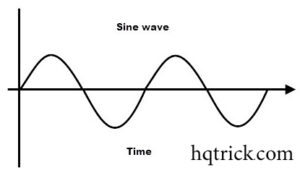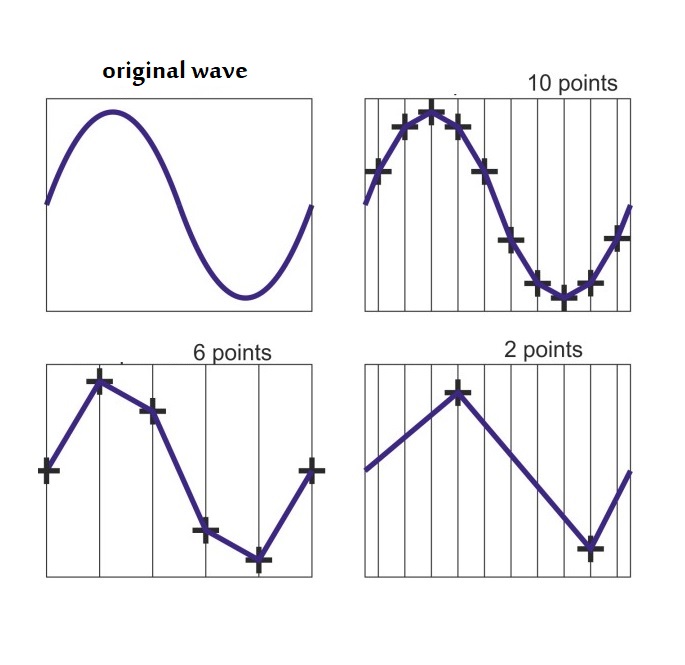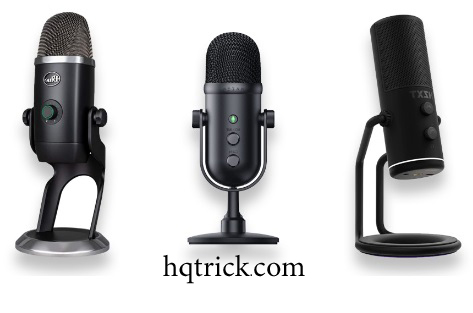Before buying the right microphone, it is essential to understand what microphones are and their functions.
Microphones are transducers that convert sound waves into electrical signals. They are vital tools for recording or broadcasting audio, enabling clear, professional sound quality in podcasting or any other audio recording. There are various types of microphones available in the market, each with unique features and applications.
This article will explore the world of microphones, including different types, their uses, and how they work. It will cover everything you need to know before purchasing the right microphone for you.
Before choosing the right microphone, it is important to understand the basic concepts.
Microphone specifications often display two important terms: Sample Rate and Bit Depth (also known as sampling rate). These terms are displayed as Bit Rate (e.g., 16 bits) and Sample Rate (e.g., 44100 Hz). But what do these terms mean?
For high-quality audio transmission, a good basic principle to keep in mind is 44.1kHz and 16-bit. This is more than sufficient for broadcasts, which focus on conveying sounds rather than complex musical instruments.
Let me take you from the beginning 🙂
As you know, computers don’t interact with shapes, sounds, and colors directly. Instead, they rely on a digital language that translates this data into information that the device can understand. This language uses binary numbers 1 and 0, where the presence of a phoneme is represented by the number 1, and the absence of a phoneme is represented by the number 0.
When you record audio with a microphone, sound waves are transmitted through the air and received by the microphone. These waves are then converted into an electrical signal that is transmitted through a cable, representing the sound wave. The sound card translates this electrical signal into digital data that the computer can understand. In this way, the computer can play the recorded audio file and understand its content.
The following figure shows the general shape of the sound waves we are talking about. The unit hertz (Hz) is commonly used in acoustics to express the number of cycles or vibrations that sound makes per second. This unit is crucial to understanding and analyzing the properties of sound.

Imagine if the image at the top were in front of you, and I asked you to copy it as you see it and save it so that you could retrieve it whenever you want.
You could simply copy the image and save it for later use, but when it comes to computers, it is not as simple. As I mentioned earlier, the computer language is based on the binary number system (1 and 0) instead of shapes and images.
Therefore, the information will be saved as numbers that indicate points on the wave, not as a traditional photograph.
In summary, the revised text is:
Imagine if the image at the top were in front of you, and I asked you to copy it as you see it and save it for later retrieval.
Copying and saving the image is simple, but when it comes to computers, it is not that straightforward. As mentioned earlier, computer language is based on the binary number system (1 and 0), not on shapes and images.
Therefore, the information will be saved as numbers that indicate points on the wave, not as a traditional photograph.

This means that instead of recording the entire wave, the device divides each second into specific points (for example, 23 points), as shown in the image above. The location and height of each point are saved, and then they are connected to each other to create an image of the wave. Although the resulting image is not 100% identical to the original, it is very similar.
Let’s return to the two terms and ask: What is “Sample Rate”? In simple terms, we can say that it is the rate at which points are taken from the sound wave every second, upon which the digital sound wave is constructed.
In other words, the original sound wave is converted into digital signals by periodically sampling the waveform, and the higher the sampling rate, the better the quality of the resulting sound.

PLEASE NOTE THE PICTURE AT THE TOP LEFT…IT IS THE ORIGINAL WAVE.
As for the image in the lower part, it shows 6 dots placed per second (to be connected after). Note that the wave is similar but not identical. The distortion gets even worse when only 2 dots are used as shown in the top image in the right panel.
Using 10 points results in a much better image (i.e., the more points we use, the more accurate the resulting wave, and the closer it is to the original wave).
If the sample rate is 100, it means that every second will be divided into 100 equal parts, and each part will have a point. Finally, we connect these points to get our waveform. The higher the sample rate, the more dots per second, which reduces waveform distortion and leads to better results.
Modern devices offer the following sample rates: 44.1 kHz, 48 kHz, 96 kHz, and 192 kHz. Note that we are talking about kilohertz (kHz) and not hertz (Hz). As the sample rate increases, the number of points increases, and the distance between them decreases, leading to a reduced margin of error and more accurate results.
However, we face a problem: we did not provide the computer with information about the heights of the points placed on the wave. Thus, all these points are stored in the form of a straight line that does not distinguish between them.
Here, we come to the second term: bit depth.
On the other hand, bit depth refers to the resolution of each sample. You can think of this as an audio image made up of audio pixels. The higher the number of pixels, the clearer the image.
After the points have been identified via the sample rate, let me explain to you the concept of bit depth, which gives an identity to each point, similar to your national identity in your country.
If the depth is 1 bit (which can be 0 or 1), the dots will be split into two teams, and the waveform will appear distorted into polygons as you can see in the image above on the left. Conversely, if the bit depth is increased (2, 8, 16, 24), the number of possibilities each bit carries increases. So, the greater the depth, the greater the number of digits that make up the identity of the point. Thus, 2-bit supports 4 possibilities, 8-bit supports 256 possibilities, 16-bit supports 65,536 possibilities, and 24-bit supports 16,777,216 possibilities. This idea needs more detail, but I don’t want to complicate the issue further. Simply put, the greater the depth, the greater the accuracy and representativeness of the recorded points, and thus the more accurate the representation of the real value of the point becomes.
The idea here needs more detail, but I don’t want to go into it and make the topic more complicated than it already is. Suppose that one of the points had its true value in wave 110.4, and the value of bit depth is equal to 1. In that case, we only have two options, 1 or 0, and we would choose 1 because it is closer to the real value of the pip. The recorded value would be completely different from the real value.
When the bit depth increases and the available levels or possibilities increase, say 8 bits (256 possibilities), it will include 110.4 and will log it as (110), which is very close to the original value. Therefore, we can say that increasing the number of bits means increasing the accuracy of reading and recording, and improving the quality of the recorded wave.
Summary
Increasing both the sample rate and bit depth provides the computer with precise coordinates for specific points on a sound wave, resulting in more accurate wave plotting. As the sample rate and bit depth increase, the computer can generate a wave that more closely resembles the original sound wave.
Although differences in sound quality between varying sample rates and bit depths may be difficult to distinguish, it’s important to pay attention to the bit depth. The difference between 8-bit and 16-bit is significant, and the jump from 16-bit to 24-bit increases the number of possibilities from tens of thousands to millions.
Therefore, when recording audio, it’s crucial to prioritize bit depth and sample rate, especially for files containing critical details. It’s best to request high-quality recordings from the commentator. The MP3 format has a maximum sample rate of 48000, while the AAC format offers the highest quality in professional video editing software and can serve as a suitable alternative to MP3.
what to consider before buying a new microphone?
- Microphone Type: There are several types of microphones available such as dynamic, condenser, ribbon, and USB. Each type has its own advantages and disadvantages, and it is important to choose the one that is suitable for your needs.
- Polar Pattern: The polar pattern of a microphone determines how it picks up sound. There are several types of polar patterns such as cardioid, omnidirectional, and bi-directional. It is important to choose the one that is appropriate for the recording environment and the intended use of the microphone.
- Frequency Response: The frequency response of a microphone refers to the range of frequencies that it can capture. It is important to choose a microphone that is capable of capturing the frequency range that you require for your recording needs.
- Sensitivity: The sensitivity of a microphone refers to how much sound it can pick up. It is important to choose a microphone that is sensitive enough to pick up the sound you need, but not so sensitive that it picks up unwanted background noise.
- Budget: The price of microphones can vary widely, from a few dollars to thousands of dollars. It is important to consider your budget and choose a microphone that provides the best value for your money.
- Compatibility: It is important to ensure that the microphone you choose is compatible with your recording equipment, such as your computer or audio interface.
- Reviews: Before making a purchase, it is helpful to read reviews from other users who have experience with the microphone you are considering. This can provide valuable insight into the microphone’s performance and suitability for different recording needs.
The most common microphone pickup patterns are:
- Bidirectional/Figure-8: This pattern captures sound from the front and back of the microphone while minimizing sound from the sides. It is ideal for recording two sound sources at the same time, such as an interview.
- Supercardioid/Hypercardioid: These patterns are similar to cardioid, but have a more directional pickup, capturing sound from a smaller area in front of the microphone. They are useful for recording in noisy environments or when trying to isolate a specific sound source.
- Cardioid: This pickup pattern captures sound from the front of the microphone while minimizing sound from the sides and rear. It is ideal for recording a single sound source while reducing ambient noise.
- Omnidirectional: This pattern captures sound from all directions equally. It is useful for recording a group of people or capturing ambient sound.
- Shotgun: This is a highly directional pattern that captures sound from a very narrow area in front of the microphone. It is commonly used in film and video production to capture dialogue from a specific actor while minimizing other sounds.
What about the noise isolation of the microphone you want to buy?
Sound isolation in microphones refers to the ability of a microphone to capture sound from a specific source while reducing or eliminating unwanted sound from other sources. Here are several points to consider regarding sound isolation in microphones:
- Shock Mounts: A shock mount can help reduce vibrations and handling noise from the microphone stand or boom arm. This is particularly important for condenser microphones, which are more sensitive to vibrations.
- Noise–Canceling: Some microphones use noise-canceling technology to actively reduce background noise. These microphones use electronic circuitry to analyze the sound and cancel out unwanted noise.
- External Soundproofing: In some cases, external soundproofing measures may be necessary to reduce unwanted noise, such as acoustic panels or soundproofing foam in the recording room.
- Directionality: Microphones with directional patterns, such as cardioid or supercardioid, are better at isolating sound from a specific source and rejecting sounds from other directions. This is because the microphone is designed to pick up sound primarily from the front, while minimizing sound from the sides and rear.
- Wind and Pop Filters: Wind and pop filters can help reduce unwanted noise from wind, breathing, or plosives (popping sounds) that can occur when pronouncing certain syllables.
Overall, sound isolation is an important factor to consider when selecting a microphone for a specific application, particularly in noisy environments or when capturing sound from a specific source.
There are several types of microphones, including:
- Wireless Microphones: These microphones use a radio transmitter and receiver to transmit the audio signal without the need for a physical cable. They are commonly used for live performances and public speaking.
- Shotgun Microphones: These microphones have a long, narrow design and are highly directional, making them ideal for capturing sound from a specific direction. They are commonly used in film and television production.
- Lavalier Microphones: These microphones are small and attach to clothing, making them ideal for capturing dialogue in film and television production, as well as public speaking events.
- Dynamic Microphones: These microphones use a magnet and a coil to convert sound waves into an electrical signal. They are durable and versatile, making them suitable for a variety of applications.
- Condenser Microphones: These microphones use a capacitor to convert sound waves into an electrical signal. They are known for their sensitivity and accuracy, and are commonly used in studio recording.
- Ribbon Microphones: These microphones use a thin strip of metal (usually aluminum) suspended in a magnetic field to convert sound waves into an electrical signal. They are known for their warm and natural sound, and are often used for recording vocals, guitars, and other acoustic instruments.
- USB Microphones: These microphones have a built-in analog-to-digital converter and connect directly to a computer via USB. They are easy to set up and use, making them a popular choice for podcasters and home recording enthusiasts.
The Audio Content Industry: Basic Tools and Requirements
Are you interested in creating your own content, whether it’s audio or visual? Then you will need the tools to record and transfer your content to your computer and the internet.
If you’re just starting out, using a gaming headset and your laptop’s built-in camera can be a good beginning. This setup allows you to play games and share your thoughts with your audience. While a camera isn’t necessary, it’s worth remembering that your on-camera personality and visibility can significantly impact your popularity and reach.
If you plan to make broadcasting a mature hobby or even a profession, you will need to gradually improve the picture and sound quality of your broadcasts. To start, we recommend investing in a high-quality microphone and the appropriate lighting for your broadcast space to ensure that you’re always well-lit.
The Importance of a Microphone for Broadcasting
No matter how great your video is or how engaging your content is, it’s all meaningless if your audience can’t hear you clearly. That’s why investing in a high-quality microphone should be your top priority.
But is the microphone on your headset or laptop sufficient? Although mid to high-end gaming headsets often have decent microphones, they are usually not as effective as standalone microphones.
A common issue with headphone microphones is that they transmit unwanted background noise, such as breathing sounds or keyboard clicks. While laptop microphones may be acceptable for voice commands or internet calls, the quality may be subpar and unpleasant for listeners if you want to create your own audio content.
Microphones can be mounted on your desk or on an arm above your monitor, allowing for a comfortable distance from the speaker and reducing unwanted noise. Additionally, speaking without a headset can lead to clearer articulation and less stress on the temporomandibular joint, making it easier to speak for extended periods.
So, if you’re serious about broadcasting, investing in a quality microphone is a must.
